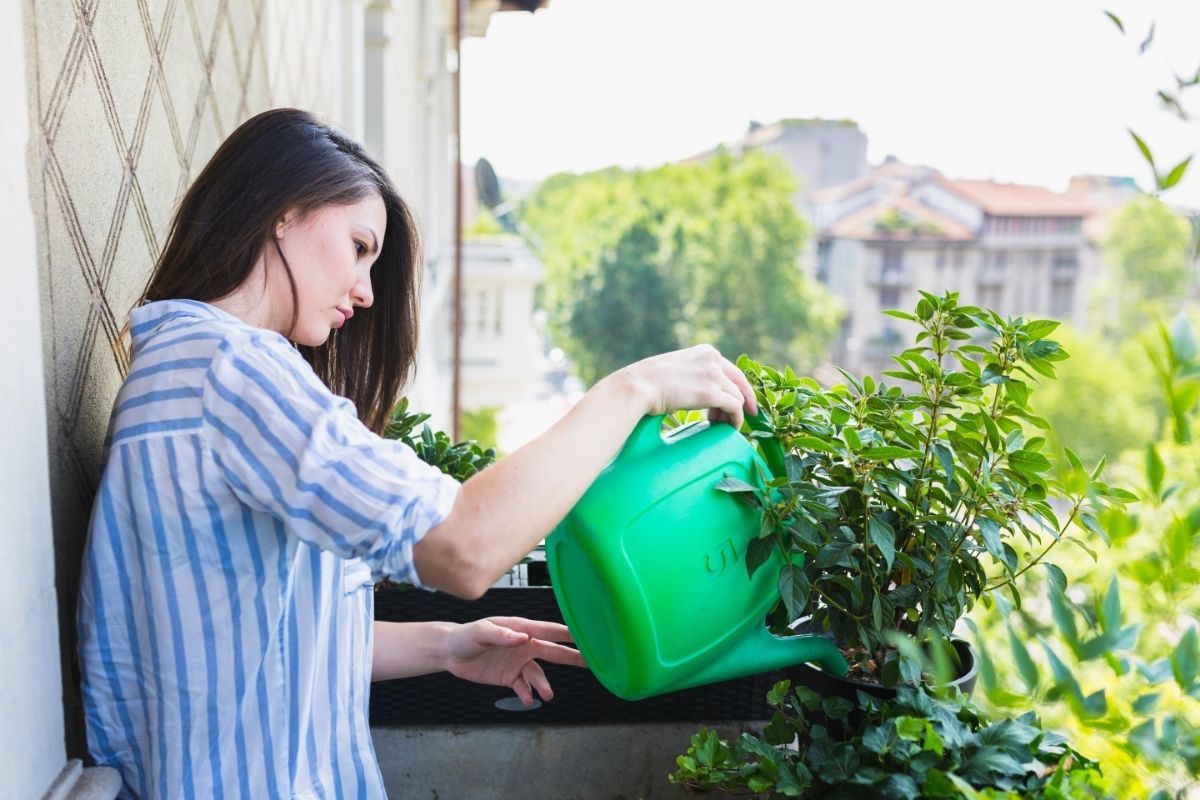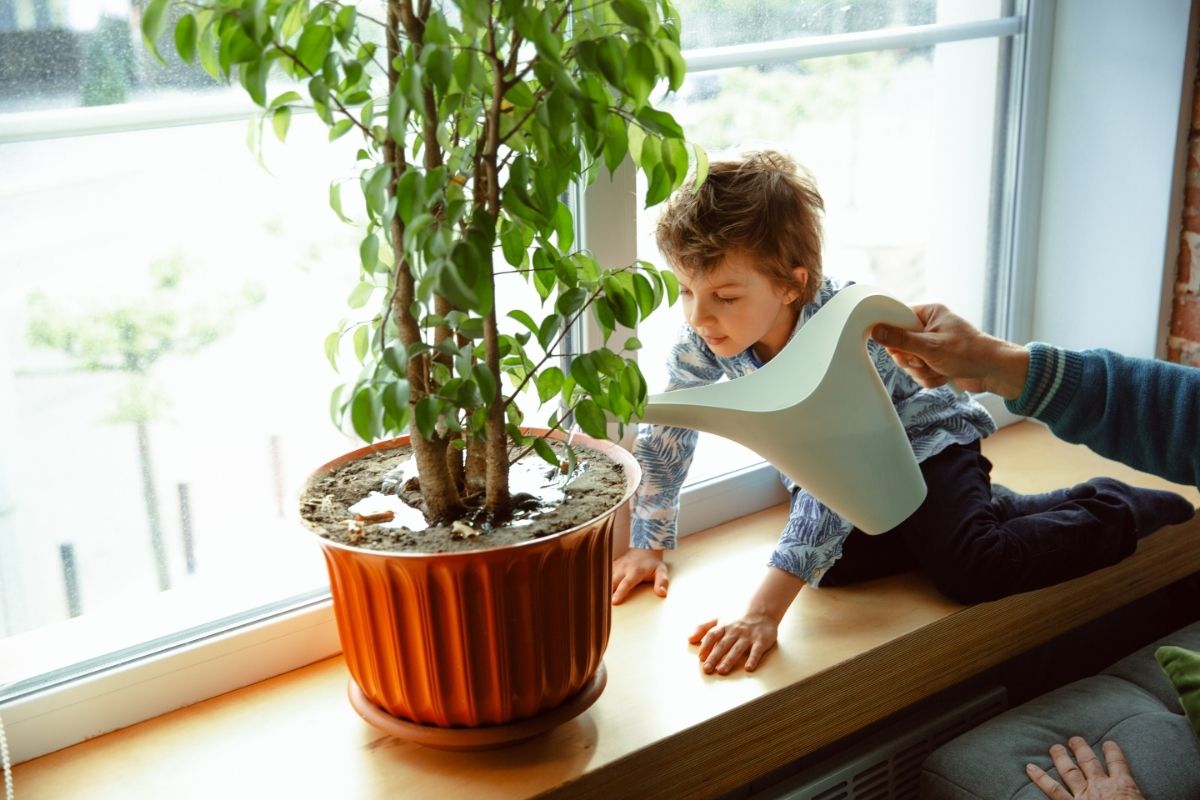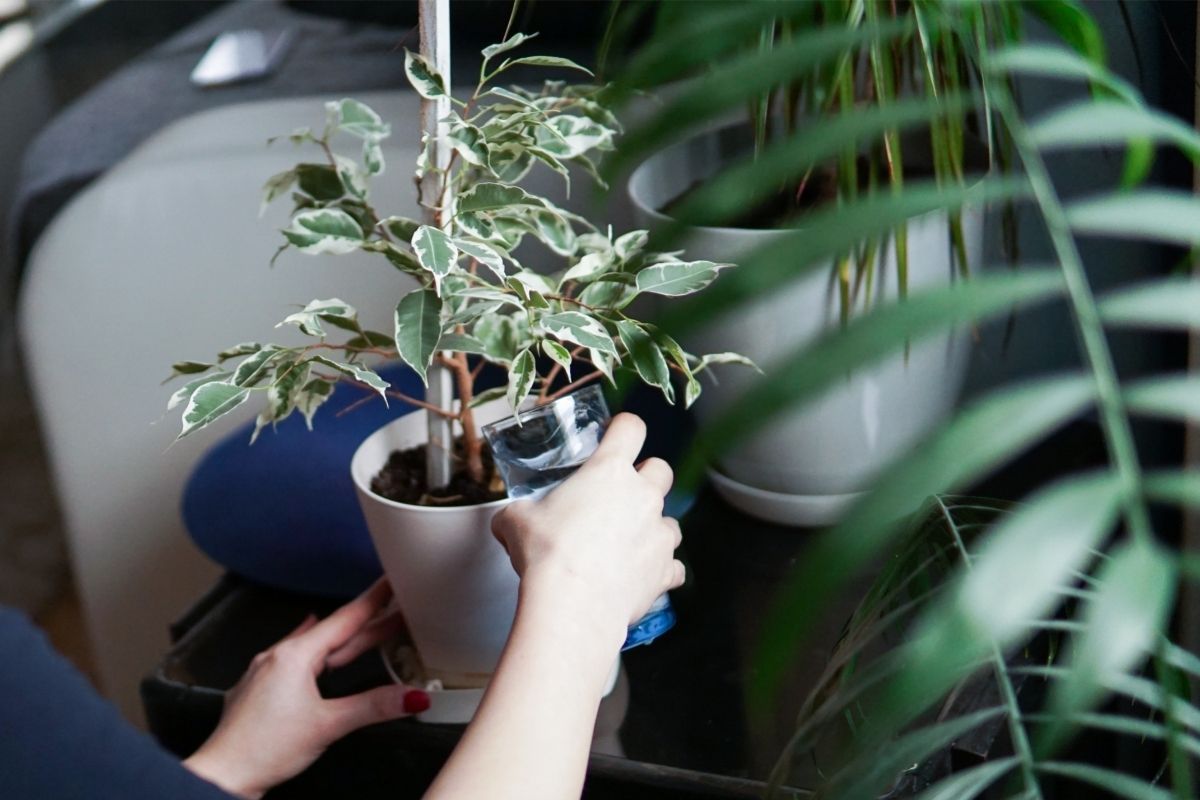Houseplants enhance indoor spaces, promoting both aesthetics and health. This guide focuses on caring for indoor plants, with essential tips on how to water indoor plants effectively, which are also applicable to outdoor gardens.
The principles discussed may also apply to other types of plants, such as cut flowers or house trees. Houseplants became popular in the late 1800s, but have been a part of the lives of humans for a long time before that.
If you need to learn more about houseplants, and specifically how to water them, you’re in the right place! In this post, we are going to focus on watering your houseplants. Since every plant is unique, they all have some special needs that you need to consider.
However, when it comes to watering, most plants are easy to please. As long as you follow specific instructions about the species, your plant will be happy and healthy in your home.

A Bit About Plants
Many people have no idea that plants require regular attention just like any other living thing. Your plant’s health depends on both good nutrition and adequate moisture availability.
This includes providing sufficient air circulation, which is essential for photosynthesis (the process by which plants convert light energy from sunlight into chemical energy stored in food).
If air doesn’t circulate properly, especially at nighttime when temperatures drop, then the leaves remain too hot and dry. As a result, pests can feed off the foliage at night. In addition, if there isn’t enough oxygen circulating through the air in the room to support plant growth, a variety of problems might develop.
Houseplants rely on you to provide everything for them — including water. Most houseplants prefer soil with high levels of nutrients, along with ample access to fresh water. You must make sure that the watering container is large enough so that water is never left standing around overnight.
When not in use, let your houseplants sit in a tray filled with moist pebbles, sand, moss or coir fibers. Also, don’t forget that your plants receive less sunlight during winter months. For instance, only use half the amount of light bulbs needed during summer.
Indoor Plant Care
Most plants, like many animals, do better with regular watering than infrequent ones. Every week or two, give plants a good watering with a watering can or anything else, as long as it is fresh water.

Some plants also need to be sprayed with a spray bottle in order to stay healthy. These plants typically come from humid environments where there is a lot of water in the air. To ensure that they are as healthy as possible, you should try to recreate their natural environment.
The following are tips for keeping houseplants thriving:
● Make sure the pot has drainage holes or trays with drainage material. Never put plants in ceramic pots without holes. Always choose plastic pots as these are lighter and easier to move around.
● Use repotting tools to remove old potting mix from each plant, mixing up new potting mix to suit your plant’s current requirements.
● Be careful with fertilizers – too much nitrogen will cause leaf burn or yellowing symptoms. Pick one that contains balanced and well-balanced elements.
● Feed your plants once every 2 weeks using a diluted liquid fertilizer. Avoid getting the fertilizer directly onto the root system.
● Keep an eye out for small insects like aphids and spider mites, and apply a suitable pesticide containing neem oil.
Why Is It So Difficult To Look After Plants?
Plants need watering to enjoy life. It seems such a simple notion, but many people fail to remember to keep their indoor plants watered. Although our green fingers may tell us that we can easily grow our own plants, this is not always true.
The truth is that most indoor plants do best in the care of professionals who have taken the time to learn about how to grow plants successfully indoors. People who are not used to caring for plants often think that the endeavor is easy, but there is a lot that can go wrong if you do not know what to look out for.
If you aren’t familiar with the warnings that plants can give you, it’s easy to miss then they are in distress. Since your indoor plant relies on you, you need to always do your best to give it everything it needs to thrive.
Watering-Related Signs Of Distress In Your Plants
Being overwatered or under watered can be very problematic for your plants. Below are some of these issues that will occur in different instances.
If you notice any of these things in your plants at home, you need to take immediate action to try to remedy the situation. If you elect to ignore it, there is a chance that your plant will die.
Overwatering Your Plants
Overwatering results in soggy plants that suffer disease and die. When you overwater your plants, the excess water ends up sitting in the soil, soaking into the roots.
This causes rot and disease because bacteria and fungi love the moist conditions, leading to death. In addition, over-watering encourages pests and diseases to thrive, so you end up fighting infection instead of helping it.
Soggy, wet leaves are not only unattractive; it also prevents light from reaching the roots and the rest of the plant. Without adequate lighting, your plant cannot perform photosynthesis and convert CO2 into other materials.
The best solution to preventing problems caused by overwatering is to use a rain gauge or timer to control your plants’ watering schedule.
You can pick up a digital rain gauge online for less than $20 and can help keep your plants healthy and happy. A digital timer lets you set daily, weekly, biweekly, monthly, seasonal, or annual schedules.
Under watering Your Plants
Being under watered can lead to damaged plants that don’t bloom as expected. To avoid this issue, make sure to check your plants periodically and add water or feed as necessary.
Sometimes when you forget to water your plants, you can see evidence of water damage in the form of wilted leaves. However, the severity of the issue depends on the amount of water and duration.
Even though it may seem counterintuitive, it is important to let your plants dry out between watering. Keeping them constantly saturated leads to fungal infections.
Most indoor plants can tolerate drier periods during the day, but once night falls, keep them watered until they start to wilt again. By doing this, you protect your plants from serious illness.
When you’re keeping an eye out for signs of drought, know that even slight changes in moisture levels can produce dramatic effects on your plants. For example, too much humidity can result in algae growth and leaf drop.
But low humidity is just as detrimental, causing yellowing leaves or browning stems. It’s essential to find a balance in between the two.
Using The Right Potting Mix For Your Plants
Believe it or not, there are many people who think that any plant will do well in any potting mix. This is not true because the type of soil you put in your pots impacts the color of your plants and their overall health.
Depending on what you have available to choose from, you either select one that suits all types of plants or one that is tailored specifically for each kind of plant. There are three categories of mixes: 1) peat moss, 2) perlite, and 3) coco peat. Below, we’ll discuss the differences among these categories.
Peat Moss
Peat moss is simply organic material from decomposed vegetation. It has very high drainage properties and absorbs air easily, meaning it allows oxygen to enter into the root zone. This helps boost the rate at which decomposition occurs, ensuring that nutrients are released into the soil.
Because peat moss does not retain heat like other mixtures, it doesn’t warm up during winter, making it perfect for colder climates. Peat moss helps with temperature regulation indoors. When combined with sand or fine gravel, it creates the ideal growing environment for houseplants.
Perlite
Perlite is used quite often in gardening books because it comes in such a wide variety of colors and textures, while still maintaining good drainage properties. Perlite particles act similarly to lava rocks but are far denser, thus allowing for better root development.
It also helps prevent roots from getting stuck in the sides of the pot and prevents disease-causing fungus from developing. It’s inexpensive, easy to work with, and effective. Just be careful not to confuse it with cork, since it isn’t made from the same materials.
Coco Peat
Coco peat is made from natural coconut fiber, which retains heat during the summer months while releasing moisture in the winter. Due to its high porosity, co-peat has excellent draining abilities, allowing excess water to seep through rather than pooling around the base of the pot.
When used by itself, it works best in warmer environments where higher temperatures aren’t required. As a matter of fact, coco peat is frequently used in tropical habitats and humid regions because its water retention capacity makes it suitable for year round care.
Watering Plants – Why Potting Mix Is Important
Using the correct potting mix for your specific plant is incredibly important. This is because the mix is directly corrected to the type of plant and its watering preferences. For example, a succulent such as a cactus will is a potting mix that is more porous to allow excess water to drain off.
While this may sound restrictive, it actually means that your desert dwelling friend will live longer and thrive. On the contrary, if you want your potted indoor bromeliads to grow quickly and bloom brightly, then using a mixture with high levels of fertilizer should help ensure they get the nutrition they need.
The point being, different plants require different potting mixes. If you were to use a potting mix that retains moisture too much, your succulents would die. Similarly, if you used a potting mix that was not good at retaining moisture for your more tropical plants, they would suffer.
The Perfect Plant Container
The container your plant is in is also important in regard to watering. Some plants will require various sizes and depths, so always be sure to look out for this when you buy your plant. Doing a quick search of your plant on the internet should tell you everything you need to know about it, and you need to follow the instructions.
Additionally, some plants may require other materials like pebbles and stones at the bottom of their pots to aid in draining. Again, you simply need to find out what your specific plant prefers.
Containers, whether they be indoor or outdoor, need a special surface treatment before they can hold plants safely. If you have clay pots, use a good quality container wash; if you have plastic containers, wipe them down as well.
You might think that a simple rinse will do, but unfortunately, many store-bought soils contain chemicals that cause problems when exposed to direct sunlight. The issue with these products is that they absorb the sun’s rays just like dirt does without providing any protection.
Using a dish soap or vinegar solution will remove most synthetic ingredients and leave behind some form of residue that won’t harm your pot. Once you’re done cleaning, dry out both the soil and the container thoroughly.
General Rules To Follow When Watering Plants
As you know now, every plant will have different needs that you need to meet. However, there are some general rules that you can follow to correctly water your indoor plants. Following these guidelines will help you take better care of your plants and not over or underwater them.

Most indoor plants should get watered around once a week, but this may not always be the case depending on where you live. In the summer, plants may need to be watered more frequently, possibly even twice or three times a week.
Watering should happen less often in the colder months, however. Generally, in the winter, you should only water your plants once a week, perhaps even once very two weeks or so.
Instead of having a rigid watering schedule, it’s better to physically feel when you should water your plants. You can do this by checking the topsoil and seeing if it is dry or moist. If it is dry, you should water your plant. If the soil is still wet two weeks after watering your plant, it does not need more.
Secondly, each plant has an ideal watering time, which will vary based on the type of plant. For example, houseplants should never go thirsty, while annuals should be watered during blooming season.
It is important to note that certain types of plants that grow the best indoors cannot tolerate extended periods of drought. This includes ferns, cacti, and mosses. As such, make sure that you give them sufficient amounts of water and that they have adequate drainage.
When it comes to water succulents, you should always allow time in between watering to let the soil dry out. Because these plants store water in their leaves, they do not need to be watered as often as your standard garden plants.
However, you will definitely want to keep them hydrated throughout the year. The best thing to do is give them around two weeks between watering, but always check if the soil is moist or dry before adding more water.
Frequently Asked Questions
What is a houseplant?
A houseplant is a plant that can be of various sizes that is grown indoors. Popular houseplants include monsteras, orchids, snake plants, and fig leaf plants
Are houseplants good for your health?
Houseplants are thought to be good for your health. Not only are they attractive, which is beneficial in itself, but they may also have the power to boost concentration by up to 15%. Even at its most basic, seeing pretty things makes us happier, so yes, plants are beneficial for your health.
Are houseplants eco-friendly?
Houseplants are eco-friendly. Even in terns of transporting them from one place to another, they do not make up a large amount of carbon emissions.
Do houseplants purify the air?
Research has shown that houseplants actually do little to nothing to purify the air in your home. Unfortunately, in order for air to get purified, you would need to have a very large number of plants to have any effect at all.
Having one or two houseplants in your home will not be beneficial to the environment, though they will be great decorations.
Final Thoughts On Watering Plants
Like everything else alive, plants need water to survive. However, too much of a good thing can still kill you, and plants are no different. Always make sure to keep an eye on your green friends for any signs of distress or suffering.
While some plants are easy to take care of, there are plenty of species that are fussier. The best thing you can do it carry out some research of the specific plant you have, and work from there.
From their watering preferences to potting soil, and even their pots themselves, every plant species will have needs that must be met.







